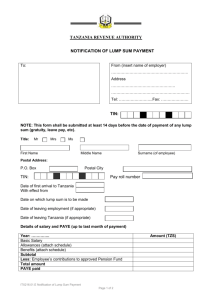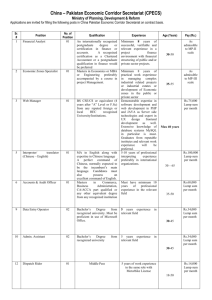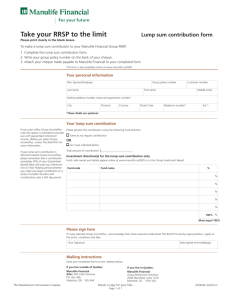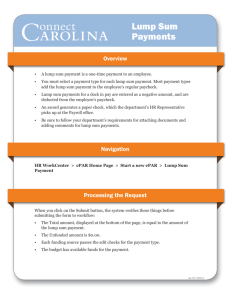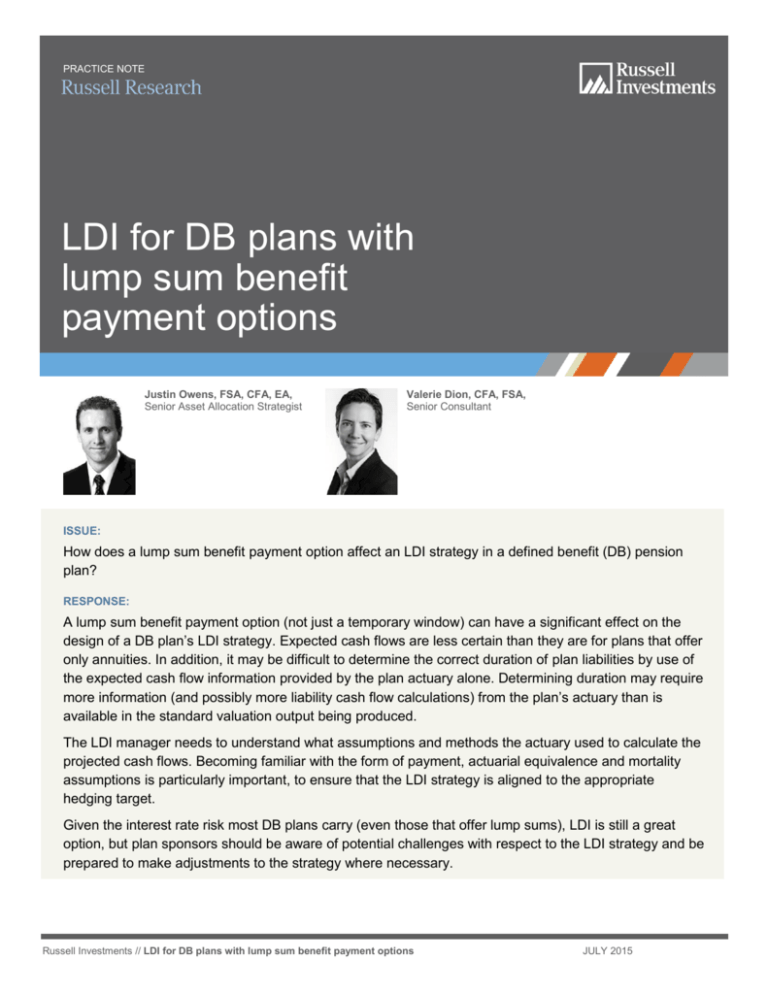
PRACTICE NOTE
LDI for DB plans with
lump sum benefit
payment options
Justin Owens, FSA, CFA, EA,
Senior Asset Allocation Strategist
Valerie Dion, CFA, FSA,
Senior Consultant
ISSUE:
How does a lump sum benefit payment option affect an LDI strategy in a defined benefit (DB) pension
plan?
RESPONSE:
A lump sum benefit payment option (not just a temporary window) can have a significant effect on the
design of a DB plan’s LDI strategy. Expected cash flows are less certain than they are for plans that offer
only annuities. In addition, it may be difficult to determine the correct duration of plan liabilities by use of
the expected cash flow information provided by the plan actuary alone. Determining duration may require
more information (and possibly more liability cash flow calculations) from the plan’s actuary than is
available in the standard valuation output being produced.
The LDI manager needs to understand what assumptions and methods the actuary used to calculate the
projected cash flows. Becoming familiar with the form of payment, actuarial equivalence and mortality
assumptions is particularly important, to ensure that the LDI strategy is aligned to the appropriate
hedging target.
Given the interest rate risk most DB plans carry (even those that offer lump sums), LDI is still a great
option, but plan sponsors should be aware of potential challenges with respect to the LDI strategy and be
prepared to make adjustments to the strategy where necessary.
Russell Investments // LDI for DB plans with lump sum benefit payment options
JULY 2015
Background – DB lump sum options
For certain types of DB plans – such as mature plans where the majority of participants
currently receive annuities – the reliability and consistency of expected cash flows is high.1
However, this can change when a plan offers lump sums; cash flow projections certainty
diminishes. See Figure 1 below, which shows the benefit payment pattern for two plans,
where one pays only annuities and where in the other, nearly all participants elect to take a
lump sum distribution.
Actual benefit payment
Figure 1: Comparison of the actual cash flow pattern of annuity vs. lump sum–
paying plan
10,000,000
Lump sum options
that are not part of a
temporary window
are protected plan
features and usually
cannot be eliminated.
8,000,000
6,000,000
4,000,000
2,000,000
1
2
3
4
5
6
7
8
9
10
Year
DB plan paying lump sums
DB plan paying annuities
Source: Form 5500 filings, Department of Labor, as of July 2014. Available at: www.dol.gov
Notice how the annuity-paying plan’s cash flow pattern varies in a smooth, fairly predictable
manner, whereas the lump sum–paying plan’s cash flow pattern is volatile and harder to
forecast. The annuity pattern is typical, because annuities are paid over a long period, with
changes (retirements, deaths) only slightly affecting the overall pattern. In contrast, lump sum
payouts vary significantly, as each is a one-time event per participant, and as timing and
amounts can vary greatly between participants. This makes the payouts more sporadic.
Lump sum options that are not part of a temporary window2 are protected plan features and
usually cannot be eliminated. There are generally two main types of lump sum options for DB
plans – those paid from traditionally designed DB plans, and those paid from hybrid plans
(cash balance, pension equity, etc.). In a traditional DB plan (about a quarter of which offer
lump sum options3), the benefit is defined and communicated as an annuity, then converted to
a lump sum, using interest rate and mortality assumptions. In a hybrid plan, the benefit is
defined and communicated as a lump sum; therefore, no conversion is necessary. The way
lump sums affect LDI strategy is quite different for each plan type.
Cash flow duration and its importance to LDI
DB liabilities usually increase as interest rates fall, and DB sponsors generally lose funded
status when rates fall, as has occurred repeatedly in recent history. In contrast, fixed income
investors generally gain when rates fall.4 DB plan sponsors can take advantage of these
offsetting effects through LDI. The sponsor can help offset the interest rate risk of a DB plan’s
liability by investing in bonds with interest rate sensitivity similar to that of their liabilities. To
know the interest rate risk, an LDI manager will often calculate liability duration and key rate
durations (not covered in detail here), using the plan’s expected cash flows provided by the
actuary. We call this “cash flow duration.”
An LDI manager will
often calculate liability
duration using the
plan’s expected cash
flows provided by the
actuary.
Once cash flow duration is known, the LDI manager can determine the appropriate bond mix
to meet the sponsor’s hedging goals. Unfortunately, when a DB plan offers lump sums, the
duration calculated by use of expected cash flows is not necessarily a close estimate of the
actual liability duration. Unlike plans paying only annuities, each projected cash flow may
change when interest rates change.
Russell Investments // LDI for DB plans with lump sum benefit payment options
2
Just as interest rates can affect lump sum cash flows, other actuarial methods and
assumptions the actuary uses to produce the cash flows play important roles.
Actuarial equivalence assumptions
One key assumption that carries significant weight for the cash flows is the actuarial
equivalence assumption – the basis for converting an annuity benefit into a lump sum. The
lump sum benefit from a traditional DB plan is the present value of the annuity benefit,
calculated using the actuarial equivalence assumption. The basis for the conversion has two
components – the interest rate (used to discount payments) and the mortality table (used to
estimate how many annuity payments will be made). Pension law requires that lump sum
options be at least as large as calculated by use of the interest rate and mortality assumptions
defined in IRC 417(e)(3).5 An example of converting an annuity to a lump sum benefit is
shown in Figure 2, below.
Figure 2: Example of IRC 417(e)(3) lump sum calculation age at 65
Assumes 2015 unisex IRS combined mortality and May 2015 interest rates; assumes beginning of
year benefit payments
A
B
C: (A*B)
D
E: (1+D)-N
F: (C*E)
PROBABILITY
OF SURVIVAL
EXPECTED BFT PMTS
AGE
ANNUITY
BENEFIT
(CASH FLOWS)
INTEREST
RATE
DISCOUNT
FACTOR
ANNUITY BENEFIT
DISCOUNTED TO AGE 65
65
100
100%
100
1.38%
100%
100
66
100
99%
99
1.38%
96%
98
67
100
98%
98
1.38%
92%
95
68
100
97%
97
1.38%
89%
93
69
100
96%
96
1.38%
85%
91
70
100
94%
94
3.88%
82%
78
71
100
93%
93
3.88%
79%
74
72
100
91%
91
3.88%
76%
70
73
100
90%
90
3.88%
73%
66
74
100
88%
88
3.88%
70%
62
75
100
86%
86
3.88%
68%
59
76
100
84%
84
3.88%
65%
55
77
100
81%
81
3.88%
62%
51
78
100
79%
79
3.88%
60%
48
79
100
76%
76
3.88%
58%
45
80
100
73%
73
3.88%
56%
41
81
100
69%
69
3.88%
53%
38
82
100
66%
66
3.88%
51%
35
83
100
62%
62
3.88%
49%
31
84
100
58%
58
3.88%
47%
28
85+
100
…
…
4.98%
46%
Present Value, Lump Sum, Sum of Column F
119
1,377
In this example, the age 65 annuity benefit of $100/year has a present value (lump sum value)
of $1,377. The lump sum changes when either interest rate or mortality assumptions change.
When using IRC 417(e)(3), which is set by the IRS, interest rates usually change every year.
Russell Investments // LDI for DB plans with lump sum benefit payment options
3
Challenges in duration calculations and potential solutions
Consider a simple illustrative example. A DB plan has one plan participant, age 60 with a
lump sum benefit due at age 65. We are trying to determine the liability duration by
discounting cash flows.6 Assume that both the liability discount rate and lump sum conversion
rate are tied to a corporate bond yield curve and both are currently 4%. We show three
scenarios for calculating liability and duration:
1.
Lump sum paid at age 65 – lump sum conversion rate remains constant (static cash
flows)
2.
Lump sum paid at age 65 – lump sum conversion rate changes with the discount rate
3.
Annuity paid at age 65 – prior to conversion to a lump sum
Liabilities are then calculated at 4% and 5%, and using both, we determine the cash flow
duration (roughly the percentage change due to the interest rate change).
Figure 3: Cash flow example
Assumes 2015 IRS unisex combined mortality for liabilities and lump sum conversion. 7
2) LUMP SUM CASH FLOW
1) LUMP SUM CASH FLOW
(CONVERTED USING SAME RATE
AGE
(CONVERTED ASSUMING 4% INTEREST)
AS DISCOUNT RATE)
3) ANNUITY SUBSTITUTION
60
0
0
0
61
0
0
0
62
0
0
0
63
0
0
0
64
0
0
0
8
65
1,374
1,374/1,261
100
66
0
0
99
67
0
0
98
68
0
0
97
69
0
0
96
70+
…
…
…
Liability (@ i=4%)
$1,129
$1,129
$1,129
Liability (@ i=5%)
$1,077
$988
$988
Cash Flow Duration
5 years
14 years
14 years
Scenario 1 reflects the actuary’s best estimate for future benefit payments, but its cash flow
duration (5 years) is inconsistent with actual liability duration, since the $1,374 lump sum will
change as rates do (this scenario assumes conversion rates stay constant). Scenario 2
reflects the correct duration but does not result in a static set of cash flows, making it less
useful for LDI purposes (the actuary would have to provide multiple sets of cash flows, and
this would decrease the flexibility afforded to the LDI manager). Scenario 3 shows the correct
duration as well, and has the added benefit of being static cash flows. The cash flow durations
for Scenarios 2 and 3 are the same, indicating that annuity cash flows may be an acceptable
method for determining liability duration. In contrast, using the lump sum cash flows (Scenario
1) could lead to under-hedging interest rate risk, as the lump sum cash flows, masking their
actual sensitivity to interest rates, do not tell the complete story on liability duration.
Under certain conditions, an effective way to solve for this issue is to use the underlying
annuity cash flows in place of the lump sum cash flows. This means that the actuary codes all
benefits as an annuity, even if the expectation is that most plan participants will take a lump
sum. This is called annuity substitution and will result in cash flows as shown in Scenario 3.
While this projection of cash flows may be a poor estimate of actual future benefit payments
(as may be used to determine liquidity needs), it provides a more accurate estimate of the
liability’s interest rate sensitivity when duration and key rate duration are determined by
discounting cash flows. Annuity substitution only works for this purpose when the liability
Russell Investments // LDI for DB plans with lump sum benefit payment options
An effective way to
solve for issues
related to lump sums
could be to use the
underlying annuity
cash flows.
4
discount rate and lump sum actuarial equivalence basis are similar (e.g., both use corporate
bond rates).
Annuity substitution does not apply when the plan’s conversion rate is fixed. For example, if
the conversion were based on a fixed 4%, then the lump sums themselves would not be
sensitive to interest rate changes. Therefore, the lump sum–based cash flows (like Scenario
1) would be the best source for determining liability duration.
Another important aspect of the actuarial equivalence assumption to consider is whether the
actuary uses a lump sum conversion rate assumption that is much different from the discount
rate. As an example, assume the liability discount rate is 4%, but that the actuary assumes a
lump sum conversion rate of 6%. Using the same parameters as above, the cash flows with
lump sums could be dramatically lower than those assuming no lump sums. The liability
calculated by use of those two sets of cash flows would differ significantly.
In DB plan design, many variations of lump sum actuarial equivalence exist, such as using
Treasury interest rates, the greater of two formulas, etc. but the IRC 417(e)(3) and fixed-rate
assumptions are probably the most common. They are also the most easily understood and to
factor into your LDI program. With less common actuarial equivalence provisions, cash flow
duration uncertainty can increase, as other approaches to adjusting your LDI program
become more complex.
In DB plan design,
many variations of
lump sum actuarial
equivalence exist.
In some cases, providing underlying annuities for LDI purposes will require extra work by the
actuary, especially to produce these cash flows for the first time. Sponsors will therefore need
to assess if the additional time/expense required is warranted to improve the effectiveness of
the LDI strategy. If the cash flows including lump sums are sensitive to interest rates, an
adjustment to the duration calculated by use of the projected cash flow must be made for
purposes of LDI. If the sponsor is satisfied with a rough estimate, the duration of an average
DB plan could be used.
Form of payment assumptions
Another major assumption that sets the future pattern of pension cash flows is the probability
that a participant will elect a certain form of benefit payment (e.g., single life annuity, lump
sum, etc.). For those plans that offer lump sums but where the take rate is lower, the effect on
the LDI program will be less. On the other hand, if the take rate for a lump sum option is high,
the factors mentioned above must be taken into account to maintain the effectiveness of the
LDI strategy (the take rate for lump sums in Figure 1 was nearly 100%).
Closely tied to this assumption is the timing of benefits (i.e., when participants will retire and
start receiving payments). The timing of payment assumption can be simple, such as all lump
sums are paid at termination, or at age 65 (even though payments might be permitted anytime
in between). While the actuary may believe these assumptions are adequate for liability
purposes, they can significantly misrepresent the plan’s liability duration, which over the long
term reduces an LDI strategy’s effectiveness. Even for more sophisticated assumptions,
which provide a range of probabilities across ages based on historical experience and
expectations for the future, the pattern will be volatile, and regular refinements may be
necessary. The plan sponsor should work with the actuary to ensure that the assumption used
is the best estimate, based on the plan’s or a similar plan’s experience.
The mortality assumption
Another important assumption is mortality. While many corporate pension plans have now
updated the mortality assumption for accounting liabilities,9 few have updated the mortality
basis for lump sum conversions.10 A common valuation assumption is that lump sum mortality
will remain as it is today (this is the default assumption). When a traditional plan that pays
lump sums only updates liablity mortality (and not the conversion of the lump sum), the full
effect of mortality is not realized in the liabilities (i.e., the liability increase is more mild),
because expected lump sums are using “old” mortality. Therefore, the plan sponsor will have
experienced a smaller increase in liabilities than otherwise comparable, annuity-only plans will
have. Once the actuary updates lump sum mortality, sponsors can expect another liability
increase related to mortality.11
Russell Investments // LDI for DB plans with lump sum benefit payment options
While many corporate
pension plans have
now updated the
mortality assumption
for accounting
liabilities, few have
updated the mortality
basis for lump sum
conversions.
5
If the mortality assumptions for liabilities and lump sum conversions are inconsistent with each
other,12 annuity substitution cash flows are likely to fully incorporate mortality, which means
that both duration and liabilities will be higher than the cash flows that assume lump sums.
From one perspective, the sponsor may view using the annuity substitution cash flows, which
fully reflecting the “new” mortality, as an advantage. They implicitly anticipate that lump sum
mortality will change in the future. Thus, they estimate what the liability and duration will
ultimately increase to, and they may be more comfortable using this basis for their LDI
strategy. On the other hand, sponsors may wish to keep the present value of cash flows used
in their LDI program and the valuation liabilities consistent. With some additional work, the
plan’s actuary can provide annuity substitution cash flows that convert benefits to lump sums
using the current (old) mortality basis, then convert back to annuities using the updated (new)
mortality basis (double conversion). This method would provide a consistent liability between
the annuity substitution and lump sum cash flows.
Special considerations for cash balance plans
Almost all hybrid plans are lump sum–based. This is opposite to a traditional plan, where the
benefit is annuity-based, but where the lump sum can be offered as a feature. Up to this point,
our discussion has focused mostly on traditional plans that offer lump sums. Hybrid plans,
such as cash balance plans, have different factors at play.
Cash balance accounts accrue a “pay credit” (percentage of pay) each year, and an “interest
credit” (Treasury rate, fixed rate, or market return). If a plan freezes or the plan participant’s
employment terminates, the pay credits cease but interest credits continue.
When the actuary calculates the liabilities for a cash balance plan, they make an assumption
for what the interest crediting rate will be in the future. If the rate is fixed (e.g., 4%), then this
assumption is simple, and the cash flows are stable. However, if the interest crediting rate
basis is floating (e.g., 30-year Treasury rate), then the interest crediting rate assumption will
likely differ from the actual crediting rate, much as the future IRC 417(e)(3) interest rate will
likely differ from the actuary’s current assumption. When that assumption is revised as may be
necessary for the valuation, the cash flows will change.
Annuity substitution
cash flows should not
be relied upon for all
purposes.
In contrast to traditional plans that pay lump sums, there is no easy way to correct for this, but
there are still ways to approach LDI, as liability duration still exists. The interest crediting rate
assumption needs to be well understood, and it is likely that input from the actuary will be
needed to correctly gauge the liability’s duration.13
Other considerations
A common approach to addressing the issues raised with lump sums is the use of annuity
substitution cash flows. In an LDI strategy, this helps to fine-tune duration calculations, but it
should not be relied upon for all purposes. For example, expected cash flows are sometimes
used to roll forward liabilities. It would not be appropriate to use annuity substitution cash
flows in this case, since it would likely overstate the liabilities.14
Annuity substitution cash flows would also not be appropriate for determining liquidity needs –
in other words, how much money you will need in the coming year in order to pay benefits.
For this purpose, the plan should look to its own recent experience, a similar plan’s
experience and/or the actuary’s best estimate of expected benefit payments (i.e., assuming
lump sums are paid).
Conclusions and final thoughts
Sponsors of traditional defined benefit plans that pay lump sums and are pursuing LDI
strategies ought to be aware of the potential issues they face. In order to determine the most
accurate liability duration, they should understand the actuarial assumptions and methods
under consideration. The assumptions most critical to understand are the actuarial
equivalence, form of payment and mortality assumptions. It may be best for the LDI manager
to request, from the actuary, the annuity substitution version of the cash flows to determine
liability duration (and possibly key rate durations). Cash balance plans face another set of
challenges that need to be understood and consciously addressed.
Potential issues are summarized in Figure 4.
Russell Investments // LDI for DB plans with lump sum benefit payment options
6
Figure 4: Potential LDI issues for plans with lump sum benefit payment options
POTENTIAL ISSUE
EFFECT(S)
SOLUTION(S)
Interest rate sensitive lump sums
Expected cash flows become interest
rate sensitive
Cash flow duration is not equal to
liability duration
If liability and lump sum rates
are on a similar basis, use annuity
substitution cash flows
Overly simple form of payment
assumption
Unnecessarily high liability gains or
losses
Inconsistent liability duration
Discuss appropriateness of the
assumptions with the actuary
Inconsistent liability and lump sum
mortality assumptions
Using annuity substitution cash flows
leads to higher liabilities and duration
than otherwise
Accept the higher liabilities and
duration as an early recognition of
updated lump sum mortality
assumption
Request that the actuary re-calculate
annuity cash flows, using double
conversion to be consistent with
liability calculation
Variable cash balance interest
crediting rate
Expected cash flows become
interest rate sensitive
Evaluate the interest crediting rate
assumption to determine what liability
duration exists15
While offering lump sums adds an extra layer of complexity to an LDI strategy, this should not
dissuade sponsors from pursuing LDI strategies for their plans. With a proper understanding
and appropriate adjustments, LDI can reduce interest rate risk and help sponsors meet their
objectives for their plans and the plan’s participants.
1
This is why, when we hear stories about annuity purchases, they typically just involve current retirees receiving only annuities. Insurance
companies are more willing to take on retirees in payment, because there is much less risk than with participants who could elect a lump sum at
some time in the future.
For more information on temporary lump sum windows, see Owens, “Risk transfer options for defined benefit plan sponsors,” Russell Research,
2013.
2
National Compensation Survey, 2010, Bureau of Labor Statistics – Table 33, “Defined benefit plans: Availability of selected benefit features,
private industry workers.” Also see Blostin, “Distribution of retirement income benefits,” in Monthly Labor Review, April 2003.
3
4
Other financial instruments, including derivatives like swaptions, can have similar characteristics, but for simplicity are ignored in this example.
The interest rate basis in IRC 417(e)(3) uses current corporate discount rates, broken into three “segments,” and for administrative convenience
are often fixed for an entire year. Segment rates are roughly the average of rates from years 0 to 5, 5 to 20, and more than 20 years. Sponsors
choose a “stability period,” which is the length of time the assumption is fixed; and a “lookback period,” which is how many months prior to the
stability period they choose rates. Stability periods can be monthly, quarterly or annually. Lookback periods range from 0 to 5 months.
5
6
Discount cash flows at two different rate and use the difference to calculate duration.
7
Note that the annuity cash flow decreases after age 65 to account for the relative probability of death in any given year. We have assumed no preretirement mortality.
8
1,374 assumes a 4% lump sum conversion rate. 1,261 assumes a 5% lump sum conversion rate.
9
See Owens, “How will the new RP-2014 mortality tables affect my DB plan strategy?” Russell Research, 2014.
10
Lump sums determined based on IRC 417(e)(3) currently use a similar basis as funding liabilities, which have not been updated to the new RP2014 tables (in any variation) as of this writing.
While it’s likely that the mortality basis for lump sum conversions will be updated when funding liability mortality is updated, what is less certain is
which mortality table will be used by the IRS.
11
12
Note that technically, mortality assumptions for liability and lump sum purposes will always be inconsistent. This is because lump sums use a
“unisex” table (mix of male and female rates), whereas for liabilities, actuaries use sex-distinct tables.
For a more comprehensive treatise on LDI for cash balance plans, refer to Owens, Jaugietis & Sylvanus, “LDI for cash balance plans,” Russell
Research, 2014.
13
14
With a liability roll forward, benefit payments are removed. With annuity cash flows, benefit payments are spread over a longer period of time.
Therefore, if annuity cash flows are used in the roll forward, not enough liability will be removed, overstating the final liability amount.
For a more comprehensive treatise on LDI for cash balance plans, refer to Owens, Jaugietis & Sylvanus, “LDI for cash balance plans,” Russell
Research, 2014.
15
Russell Investments // LDI for DB plans with lump sum benefit payment options
7
Appendix
Summary of terms
TERM
DEFINITION (CORPORATE DB CONTEXT)
Annuity
A series of payments, typically payable until the annuitant’s death
Lump sum
A one-time payment equal to the present value of an annuity benefit
Cash flows
Expected benefit payments for current participants – used to determine the discount rate and liability duration – the
discounted cash flows are the plan’s liability.
Liability duration
A measure for interest rate sensitivity – measures the percentage of change in liabilities for a 1% change in
discount rate – best used for estimating the effect of small, parallel shifts in the yield curve
Key rate duration
Liability duration broken into maturity periods to measure interest rate sensitivity at various points in the yield curve
in isolation – preferred to liability duration for measuring non-parallel shifts (twists, butterfly shifts) in the yield curve
Cash flow duration
Duration as calculated directly from the cash flows, rather than a actuary’s valuation system
Mortality
Rate of death assumption – used in virtually all DB plans to determine expected number of annuity payments
Form of payment
The method of paying out promised DB benefits – includes single life annuities, joint & survivor, lump sum, etc.
Actuarial equivalence
A combination of interest and mortality rates used to convert annuities into other forms of payment, including lump
sums
IRC 417(e)(3)
The code section that mandates a minimum level of lump sum benefits (and a few other less common forms of
payment) by specifying the interest and mortality rates all converted lump sums must be compared with
Annuity substitution
Cash flows coded to generate annuities rather than lump sums, when lump sums would otherwise be assumed
Hybrid DB plan
A DB plan with DC plan features – benefit usually lump-sum-based – annuity must be offered – same
funding/accounting requirements as traditional DB plans – includes cash balance and pension equity plans
Pay credit
The new accrual in a cash balance benefit – usually a percentage of pay
Interest credit
The “return” on a cash balance benefit – can be a fixed rate (e.g., 4%), a market-based rate (e.g., 30-year
Treasury), a market-based asset return, or some combination of these
ABOUT RUSSELL INVESTMENTS
Russell Investments provides strategic advice, world-class implementation, state-of-the-art
performance benchmarks and a range of institutional-quality investment products, serving
clients in more than 35 countries. Russell provides access to some of the world’s best money
managers. It helps investors put this access to work in defined benefit, defined contribution
and public retirement plans, in endowments and foundations and in the life savings of
individual investors.
FOR MORE INFORMATION:
Call Russell at 800-426-8506 or
visit www.russell.com/institutional
Important information
Nothing contained in this material is intended to constitute legal, tax, securities or investment advice, nor an opinion regarding the appropriateness
of any investment, nor a solicitation of any type. The general information contained in this publication should not be acted upon without obtaining
specific legal, tax and investment advice from a licensed professional.
Russell Investments is a trade name and registered trademark of Frank Russell Company, a Washington USA corporation, which operates through
subsidiaries worldwide and is part of London Stock Exchange Group.
The Russell logo is a trademark and service mark of Russell Investments.
Copyright © Russell Investments 2015. All rights reserved. This material is proprietary and may not be reproduced, transferred or distributed in any
form without prior written permission from Russell Investments. It is delivered on an "as is" basis without warranty.
First used: July 2015
USI-22572-07-18
Russell Investments // LDI for DB plans with lump sum benefit payment options
8


